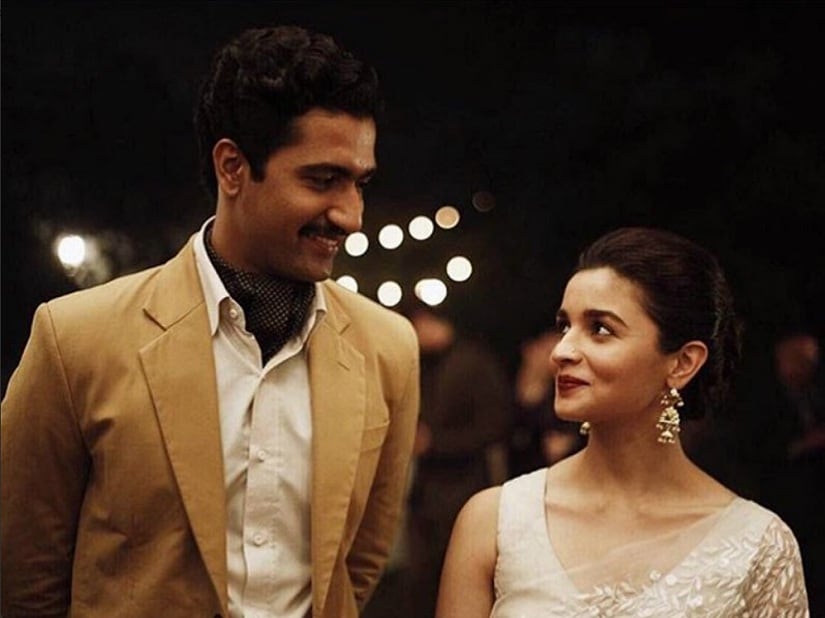
Vicky Kaushal and Alia Bhatt in Raazi
Come May, and Alia Bhatt will play a female spy, Sehmat, in a film about Indian espionage and its impact on the Kashmir insurgency. Meghna Gulzar, director of Raazi, who has delivered the razor sharp Talvar before this, adapts a book by Harinder S Sikka, Calling Sehmat, for the screen. Based on real life events to an extent, Sikka’s book tells the story of a young girl who marries the son of a high placed Pakistani Army general and then begins to pass on key secrets to Indian authorities.
Calling Sehmat draws from an important facet of the Kashmir insurgency, which has impacted lives of people her at different levels, marking their destinies with its all consuming presence in the valley. Hindi cinema has for long avoided taking the bull by its horns around the Kashmir issue. Complexities of politics and identity crises, coupled with a certain brand of instant patriotism that Kashmir evokes amongst a section of Indians have been factors in discouraging gritty, realistic films based on the conflict. Given that this is India’s longest running insurgency (along with Nagaland), that seems like a thousand missed chances. Fortunately, approaching the Kashmir issue has begun to happen on celluloid with promising projects in the pipeline.
Vishal Bharadwaj took up the unrest and represented it in poignant, dramatic hues with his interpretation of Hamlet in Haider. Basharat Peer, the journalist who has written the celebrated Curfewed Night, which is about growing up in the valley as local youth, has collaborated with Bharadwaj to bring a powerful tale of a half widow and a ‘missing’ person with Shakespeare’s ‘ghost’ becoming the conscience of its protagonists. Haider is a brilliant example of treading lightly on political toes and yet, portraying the damaged lives in the region. Before Bharadwaj’s film, there came Shoojit Sircar’s Yahaan, an artfully done love story that captured the interpretation of the military’s power and its impact on the life of individuals. For a military man to fall in love with a local woman was seen as betrayal, which reflects a mindset prevalent in the valley. Musa Sayeed’s Kashmiri film, Valley of Saints, recently won international acclaim and fared well at film festivals. A humane tale about a boatman on the Dal Lake and a scientist, this film reflects the massive international interest that the valley and its conflict always draw.
This piece doesn’t mention Fanaa or Fitoor or similar films that used Kashmir’s beauty, culture and backdrop for stories not too close to ground reality.
Instead, Vidhu Vinod Chopra, a Kashmiri Pandit himself, intrigues with his new film, Love Letters, about the exodus of the community in the '90s. To be filmed in picturesque locations where refugee camps existed, this project will feature fresh faces and will be shot on the go. Once again, a key turning point in the insurgency will be told on film.
Mani Ratnam in Roja made the most apt beginning to Kashmir’s contemporary reality. In the film, the insurgent commits to ‘wiping tears’ instead of picking up guns. Displaying signature foresight, Ratnam gave his character of a terrorist, played by Pankaj Kapur, room for reform and optimism. Rehabilitation of insurgents by the state had begun to yield results by then. But the filmmaker went off track when he tried to tackle a confused narrative of suicide bombers by merging insurgencies of the North East and Kashmir in Dil Se. Ratnam’s playing-it-safe narrative is not rooted in ground reality. He must be credited though for walking into risky territory with his films; Roja and Dil Se opened a door for exploration of the human side of the Kashmir border conflict.
The Kashmir insurgency has ample scope for celluloid stories to emerge. Be it the impact of long standing conflict on lives of common people, loss of homes and livelihoods, the stranded youth and children whose lives pause each time the conflict escalates; there are many stories of human struggle and grief to be told. Life in the beautiful valley under the shadow of guns has fuelled poetry and literature, too. The power equation between the Indian state’s iron hand and locals, provides room for exploration, as do the stories of the villagers and those living close to the border. For instance, when schools get burned down in remote areas to smoke out terrorists, do they get rebuilt immediately? If not, then where do these children go for their education? How do local people cope with regular roadblocks and highway checks when they commute for work? How does one deal with suspicion in one’s homeland?
Kashmir’s canvas of complex reality, its local culture as well as its history of tension has inspired a solid body of Indian English literature. While encapsulating all is not feasible, some make the reader travel right into the lives and realities of the valley. Be it Rahul Pandita’s Our Moon Has Blood Clots, Lamentations of a Sombre Sky by Manan Kapoor or The Collaborator and the Book of Gold Leaves by Mirza Waheed; stories of Kashmir are rich and varied.
Raazi marks a start for Bollywood films based around contemporary literature on Kashmir. Here’s hoping filmmakers and writers will take the cue from this rich, tragic and dramatic body of literature and oral histories to bring more films that connect with Kashmir’s reality in future.
Published Date: Apr 03, 2018 09:02 AM | Updated Date: Apr 03, 2018 09:02 AM